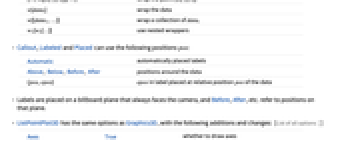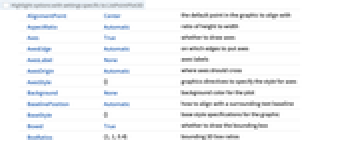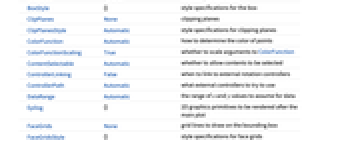ListPointPlot3D[{{x1,y1,z1},{x2,y2,z2},…}]
generates a 3D scatter plot of points with coordinates {xi,yi,zi}.
ListPointPlot3D[array]
generates a 3D scatter plot of points with a 2D array of height values.
ListPointPlot3D[{data1,data2,…}]
plots several collections of points, by default in different colors.




ListPointPlot3D
ListPointPlot3D[{{x1,y1,z1},{x2,y2,z2},…}]
generates a 3D scatter plot of points with coordinates {xi,yi,zi}.
ListPointPlot3D[array]
generates a 3D scatter plot of points with a 2D array of height values.
ListPointPlot3D[{data1,data2,…}]
plots several collections of points, by default in different colors.
Details and Options






- Data values xi, yi and zi can be given in the following forms:
-
xi a real-valued number Quantity[xi,unit] a quantity with a unit Around[xi,ei] value xi with uncertainty ei Interval[{xmin,xmax}] values between xmin and xmax - Values xi, yi and zi that are not of the preceding form are taken to be missing and are not shown.
- The datai have the following forms and interpretations:
-
<|"k1"{x1,y1,z1},"k2"{x2,y2,z2},…|> values {{x1,y1,z1},{x2,y2,z2},…} {{x1,y1,z1}"lbl1",{x2,y2,z2}"lbl2",…}, data{"lbl1","lbl2",…} values {{x1,y1,z1},{x2,y2,z2},…} with labels {lbl1,lbl2,…} SparseArray values as a normal array QuantityArray magnitudes WeightedData unweighted values - ListPointPlot3D[Tabular[…]cspec] extracts and plots values from the tabular object using the column specification cspec.
- The following forms of column specifications cspec are allowed for plotting tabular data:
-
{colx,coly,colz} plot column z against columns x and y {{colx1,coly1,colz1},{colx2,coly2,colz2},…} plot column z1 against column x1 and y1 , z2 against x2 and y2, etc. - The following wrappers w can be used for the datai:
-
Annotation[datai,label] provide an annotation for the data Button[datai,action] define an action to execute when the data is clicked Callout[datai,label] label the data with a callout Callout[datai,label,pos] place the callout at relative position pos EventHandler[datai,…] define a general event handler for the data Hyperlink[datai,uri] make the data a hyperlink Labeled[datai,label] label the data Labeled[datai,label,pos] place the label at relative position pos Legended[datai,label] identify the data in a legend PopupWindow[datai,cont] attach a popup window to the data StatusArea[datai,label] display in the status area on mouseover Style[datai,styles] show the data using the specified styles Tooltip[datai,label] attach a tooltip to the data Tooltip[datai] use data values as tooltips - Wrappers w can be applied at multiple levels:
-
{{…,w[zi,j],…}} wrap the value zi,j in array data {…,w[{xi,yi,zi}],…} wrap the point {xi,yi,zi} w[datai] wrap the data w[{data1,…}] wrap a collection of datai w1[w2[…]] use nested wrappers - Callout, Labeled and Placed can use the following positions pos:
-
Automatic automatically placed labels Above, Below, Before, After positions around the data {pos,epos} epos in label placed at relative position pos of the data - Labels are placed on a billboard plane that always faces the camera, and Before, After, etc. refer to positions on that plane.
- ListPointPlot3D has the same options as Graphics3D, with the following additions and changes: [List of all options]
-
Axes True whether to draw axes BoxRatios {1,1,0.4} bounding 3D box ratios ColorFunction Automatic how to determine the color of points ColorFunctionScaling True whether to scale arguments to ColorFunction DataRange Automatic the range of x and y values to assume for data Filling None how to fill in stems for each point FillingStyle Automatic style to use for filling IntervalMarkers Automatic how to render uncertainty IntervalMarkersStyle Automatic style for uncertainty elements LabelingFunction Automatic how to label points LabelingSize Automatic size to use for callout and label LabelingTarget Automatic how to determine automatic label positions PerformanceGoal $PerformanceGoal aspects of performance to try to optimize PlotInteractivity $PlotInteractivity whether to allow interactive elements PlotLegends None legends for points PlotRange {Full,Full,Automatic} the range of z or other values to include PlotRangePadding Automatic how much to pad the range of values PlotStyle Automatic styles of points PlotTheme $PlotTheme overall theme for the plot RegionFunction (True&) how to determine whether a point should be included RegionBoundaryStyle ![TemplateBox[{Automatic, paclet:ref/Automatic}, RefLink, BaseStyle -> {3ColumnTableMod}] TemplateBox[{Automatic, paclet:ref/Automatic}, RefLink, BaseStyle -> {3ColumnTableMod}]](Files/ListPointPlot3D.en/1.png)
style to use for a region ScalingFunctions None how to scale individual coordinates - The option setting Filling->Automatic shows stems for all points.
- DataRange determines how values {{z11, …, z1n},…,{zm1,…,zmn}} {z1q,…,zn} are interpreted into {{x11,y11,z11},…,{xmn,ymn,zmn}}. Possible settings include:
-
Automatic,All uniform from 1 to m or n {{xmin,xmax},{ymin,ymax}} uniform from xmin to xmax and from ymin to ymax - In general, a list of triples {{x1,y1,z1},{x2,y2,z2},…} is interpreted as a list of points, but the setting DataRangeAll forces it to be interpreted as multiple datai {{z11,z12,z13},{z21,z22,z23},…}.
- PlotStyle allows any graphics directive, and each directive will be applied to collections of points datai.
- The arguments supplied to functions in ColorFunction and RegionFunction are x, y and z. Functions in ColorFunction are by default supplied with scaled versions of these arguments.
-
 Highlight options with settings specific to ListPointPlot3D
Highlight options with settings specific to ListPointPlot3D
-
AlignmentPoint Center the default point in the graphic to align with AspectRatio Automatic ratio of height to width Axes True whether to draw axes AxesEdge Automatic on which edges to put axes AxesLabel None axes labels AxesOrigin Automatic where axes should cross AxesStyle {} graphics directives to specify the style for axes Background None background color for the plot BaselinePosition Automatic how to align with a surrounding text baseline BaseStyle {} base style specifications for the graphic Boxed True whether to draw the bounding box BoxRatios {1,1,0.4} bounding 3D box ratios BoxStyle {} style specifications for the box ClipPlanes None clipping planes ClipPlanesStyle Automatic style specifications for clipping planes ColorFunction Automatic how to determine the color of points ColorFunctionScaling True whether to scale arguments to ColorFunction ContentSelectable Automatic whether to allow contents to be selected ControllerLinking False when to link to external rotation controllers ControllerPath Automatic what external controllers to try to use DataRange Automatic the range of x and y values to assume for data Epilog {} 2D graphics primitives to be rendered after the main plot FaceGrids None grid lines to draw on the bounding box FaceGridsStyle {} style specifications for face grids Filling None how to fill in stems for each point FillingStyle Automatic style to use for filling FormatType TraditionalForm default format type for text ImageMargins 0. the margins to leave around the graphic ImagePadding All what extra padding to allow for labels, etc. ImageSize Automatic absolute size at which to render the graphic IntervalMarkers Automatic how to render uncertainty IntervalMarkersStyle Automatic style for uncertainty elements LabelingFunction Automatic how to label points LabelingSize Automatic size to use for callout and label LabelingTarget Automatic how to determine automatic label positions LabelStyle {} style specifications for labels Lighting Automatic simulated light sources to use Method Automatic details of 3D graphics methods to use PerformanceGoal $PerformanceGoal aspects of performance to try to optimize PlotInteractivity $PlotInteractivity whether to allow interactive elements PlotLabel None a label for the plot PlotLegends None legends for points PlotRange {Full,Full,Automatic} the range of z or other values to include PlotRangePadding Automatic how much to pad the range of values PlotRegion Automatic final display region to be filled PlotStyle Automatic styles of points PlotTheme $PlotTheme overall theme for the plot PreserveImageOptions Automatic whether to preserve image options when displaying new versions of the same graphic Prolog {} 2D graphics primitives to be rendered before the main plot RegionBoundaryStyle ![TemplateBox[{Automatic, paclet:ref/Automatic}, RefLink, BaseStyle -> {3ColumnTableMod}] TemplateBox[{Automatic, paclet:ref/Automatic}, RefLink, BaseStyle -> {3ColumnTableMod}]](Files/ListPointPlot3D.en/3.png)
style to use for a region RegionFunction (True&) how to determine whether a point should be included RotationAction "Fit" how to render after interactive rotation ScalingFunctions None how to scale individual coordinates SphericalRegion Automatic whether to make the circumscribing sphere fit in the final display area Ticks Automatic specification for ticks TicksStyle {} style specification for ticks TouchscreenAutoZoom False whether to zoom to fullscreen when activated on a touchscreen ViewAngle Automatic angle of the field of view ViewCenter Automatic point to display at the center ViewMatrix Automatic explicit transformation matrix ViewPoint {1.3,-2.4,2.} viewing position ViewProjection Automatic projection method for rendering objects distant from the viewer ViewRange All range of viewing distances to include ViewVector Automatic position and direction of a simulated camera ViewVertical {0,0,1} direction to make vertical
List of all options
Examples
open all close allBasic Examples (6)
Show a scatter plot from an array of height values:
Add labels as Callout:
Scope (36)
General Data (8)
For regular data consisting of ![]() values, the
values, the ![]() and
and ![]() data ranges are taken to be integer values:
data ranges are taken to be integer values:
Provide explicit ![]() and
and ![]() data ranges by using DataRange:
data ranges by using DataRange:
Plot multiple sets of regular data:
For irregular data consisting of ![]() triples, the
triples, the ![]() and
and ![]() data ranges are inferred from the data:
data ranges are inferred from the data:
Plot multiple sets of irregular data:
Areas around where the data is nonreal are excluded:
PlotRange is selected automatically:
Use PlotRange to focus in on areas of interest:
Use RegionFunction to restrict the surface to a region given by inequalities:
Tabular Data (2)
Include legends for the plot, using the column names:
Plot three columns as coordinate triples:
Use PivotToColumns to create columns of values for each species:
Special Data (6)
Use Quantity to include units with the data:
Plot data in a QuantityArray:
Specify the units used with TargetUnits:
Specify strings to use as labels:
Plot data in a SparseArray:
Data Wrappers (6)
Use wrappers on individual data, datasets or collections of datasets:
Use the value of each point as a tooltip:
Use a specific label for all the points:
Labels points with automatically positioned text:
Use PopupWindow to provide additional drilldown information:
Button can be used to trigger any action:
Labeling and Legending (6)
Label points with automatically positioned text:
Place the labels relative to the points:
Specify label names with LabelingFunction:
Include legends for each point collection:
Use Legended to provide a legend for a specific dataset:
Use Placed to change the legend location:
Specify the maximum size of labels:
For dense sets of points, some labels may be turned into tooltips by default:
Options (84)
Axes (3)
AxesLabel (4)
AxesOrigin (2)
AxesStyle (4)
ColorFunction (5)
Color by scaled ![]() ,
, ![]() , and
, and ![]() values:
values:
Color by scaled ![]() and
and ![]() coordinates:
coordinates:
Use ColorData for predefined color gradients:
Named color gradients color in the ![]() direction:
direction:
ColorFunction has higher priority than PlotStyle:
ColorFunctionScaling (2)
DataRange (5)
Arrays of height values are displayed against the number of elements in each direction:
Rescale to the sampling space:
Each dataset is scaled to the same domain:
Triples are interpreted as ![]() ,
, ![]() ,
, ![]() coordinates:
coordinates:
Force interpretation as arrays of height values:
The dataset is normally interpreted as a list of ![]() ,
, ![]() ,
, ![]() triples:
triples:
Filling (3)
Fill to the bottom, using "stems":
Filling occurs along the region cut by the RegionFunction:
Fill surface 1 to the bottom with blue and surface 2 to the top with red:
FillingStyle (3)
ImageSize (7)
Use named sizes such as Tiny, Small, Medium and Large:
Specify the width of the plot:
Specify the height of the plot:
Allow the width and height to be up to a certain size:
Specify the width and height for a graphic, padding with space if necessary:
Setting AspectRatioFull will fill the available space:
Use maximum sizes for the width and height:
Use ImageSizeFull to fill the available space in an object:
Specify the image size as a fraction of the available space:
IntervalMarkers (2)
LabelingSize (3)
Images in callouts and labels are resized automatically by default:
Use LabelingSize to change the display size of labels:
LabelingTarget (7)
Labels are automatically placed to maximize readability:
Use a denser layout for the labels:
Show the quarter of the labels that are easiest to read:
Only allow labels that are orthogonal to the points:
Only allow labels that are diagonal to the points:
Restrict labels to be above or to the right of the points:
PlotLegends (5)
PlotRange (3)
RegionBoundaryStyle (3)
RegionFunction (4)
The region depends on DataRange:
ScalingFunctions (5)
Ticks (6)
Ticks are placed automatically in each plot:
Use TicksNone to not draw any tick marks:
Place tick marks at specific positions:
Draw tick marks at the specified positions with the specified labels:
Specify tick marks with scaled lengths:
Customize each tick with position, length, labeling and styling:
Properties & Relations (11)
Use ListPlot and ListLinePlot to plot heights in 2D:
Use ListLinePlot3D to plot curves through lists of points:
Plot curves through rows of heights in a table:
Use ListPlot3D to create surfaces from data:
Use Plot3D to visualize functions:
Use ListLogPlot, ListLogLogPlot, and ListLogLinearPlot for logarithmic data plots:
Use ListPolarPlot for polar plots:
Use DateListPlot to show data over time:
Use ListContourPlot to create contours from continuous data:
Use ListDensityPlot to create densities from continuous data:
Use ArrayPlot and MatrixPlot for arrays of discrete values:
Use ParametricPlot for parametric curves:
Related Guides
History
Introduced in 2007 (6.0) | Updated in 2012 (9.0) ▪ 2014 (10.0) ▪ 2016 (11.0) ▪ 2018 (11.3) ▪ 2020 (12.1) ▪ 2025 (14.2) ▪ 2025 (14.3)
Text
Wolfram Research (2007), ListPointPlot3D, Wolfram Language function, https://reference.wolfram.com/language/ref/ListPointPlot3D.html (updated 2025).
CMS
Wolfram Language. 2007. "ListPointPlot3D." Wolfram Language & System Documentation Center. Wolfram Research. Last Modified 2025. https://reference.wolfram.com/language/ref/ListPointPlot3D.html.
APA
Wolfram Language. (2007). ListPointPlot3D. Wolfram Language & System Documentation Center. Retrieved from https://reference.wolfram.com/language/ref/ListPointPlot3D.html
BibTeX
@misc{reference.wolfram_2025_listpointplot3d, author="Wolfram Research", title="{ListPointPlot3D}", year="2025", howpublished="\url{https://reference.wolfram.com/language/ref/ListPointPlot3D.html}", note=[Accessed: 02-January-2026]}
BibLaTeX
@online{reference.wolfram_2025_listpointplot3d, organization={Wolfram Research}, title={ListPointPlot3D}, year={2025}, url={https://reference.wolfram.com/language/ref/ListPointPlot3D.html}, note=[Accessed: 02-January-2026]}